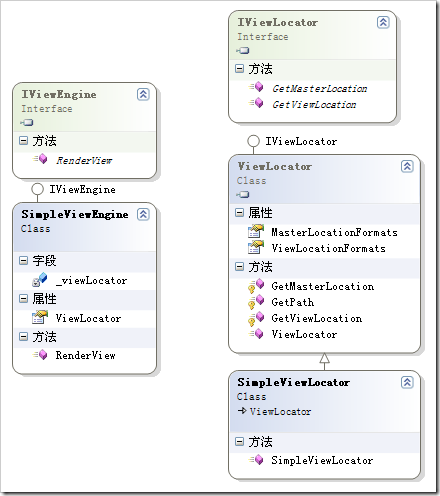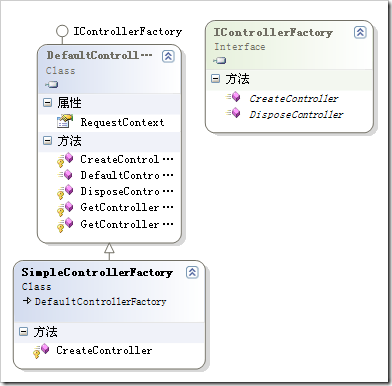ASP.NET MVC :实现我们自己的视图引擎_.Net教程
推荐:WPF自定义漂亮的按钮样式
首先打开 Microsoft Visual Studio 2008 ,新建一个WPF项目,在上面随便放几个按钮:
然后给各个按钮设置不同的背景颜色:
设置好之后就是这样啦:
然后我们就开始在 App.xaml
在ASP.NET MVC的一个开源项目MvcContrib中,为我们提供了几个视图引擎,例如NVelocity, Brail, NHaml, XSLT。那么如果我们想在ASP.NET MVC中实现我们自己的一个视图引擎,我们应该要怎么做呢?
我们知道呈现视图是在Controller中通过传递视图名和数据到RenderView()方法来实现的。好,我们就从这里下手。我们查看一下ASP.NET MVC的源代码,看看RenderView()这个方法是如何实现的:
| 以下为引用的内容: protected virtual void RenderView(string viewName, string masterName, object viewData) { ViewContext viewContext = new ViewContext(ControllerContext, viewName, masterName, viewData, TempData); ViewEngine.RenderView(viewContext); }// |
这是P2的源码,P3略有不同,原理差不多,从上面的代码我们可以看到,Controller中的RenderView()方法主要是将ControllerContext, viewName, masterName, viewData, TempData这一堆东西封装成ViewContext,然后把ViewContext传递给ViewEngine.RenderView(viewContext)。嗯,没错,我们这里要实现的就是ViewEngine的RenderView()方法。
ASP.NET MVC为我们提供了一个默认的视图引擎,这个视图引擎叫做:WebFormsViewEngine. 从名字就可以看出,这个视图引擎是使用ASP.NET web forms来呈现的。在这里,我们要实现的视图引擎所使用的模板用HTML文件吧,简单的模板示例代码如下:
| 以下为引用的内容: <!DOCTYPE html PUBLIC "-//W3C//DTD XHTML 1.0 Transitional//EN" "http://www.w3.org/TR/xhtml1/DTD/xhtml1-transitional.dtd"> <html xmlns=""http://www.w3.org/1999/xhtml"">http://www.w3.org/1999/xhtml" > <head> <title>自定义视图引擎示例</title> </head> <body> <h1>{$ViewData.Title}</h1> <p>{$ViewData.Message}</p> <p>The following fruit is part of a string array: {$ViewData.FruitStrings[1]}</p> <p>The following fruit is part of an object array: {$ViewData.FruitObjects[1].Name}</p> <p>Here's an undefined variable: {$UNDEFINED}</p> </body> < ml> |
下面马上开始我们的实现。首先,毫无疑问的,我们要创建一个ViewEngine,就命名为 SimpleViewEngine 吧,注意哦,ViewEngine要实现IViewEngine接口:
| 以下为引用的内容: public class SimpleViewEngine : IViewEngine IViewLocator _viewLocator = null; #endregion #region IViewEngine Members : RenderView() public void RenderView(ViewContext viewContext) string viewPath = viewContext.HttpContext.Request.MapPath(viewLocation); //以下为模板解析 viewContext.HttpContext.Response.Write(viewTemplate); #endregion #region Public properties : ViewLocator public IViewLocator ViewLocator #endregion |
在这里实现了IViewEngine接口提供的RenderView()方法,这里要提供一个ViewLocator的属性。ViewLocator的主要就是根据控制器中传来的视图名,进行视图的定位。在RenderView()方法中首先获取视图的路径,然后把视图模板读进来,最后进行模板的解析然后输出。
我们再来看一下ViewLocator是如何实现的。他是IViewLocator类型的,也就是说SimpleViewLocator实现了IViewLocator接口。SimpleViewLocator的实现代码如下:
| 以下为引用的内容: public class SimpleViewLocator : ViewLocator { public SimpleViewLocator() { base.ViewLocationFormats = new string[] { "~ iews/{1}/{0}.htm", "~ iews/{1}/{0}.html", "~ iews d/{0}.htm", "~ iews d/{0}.html" }; base.MasterLocationFormats = new string[] { "" }; } } |
我们的SimpleViewLocator 是继承自ASP.NET MVC的ViewLocator类,而ViewLocator则是实现了IViewLocator接口的。由于ViewLocator已经为了完成了全部的工作,这里我们只需修改下他的ViewLocationFormats 来使用我们自己的模板文件就可以了。
我们再来看一下类图,那就更加清楚了:

注:关于模板解析的部分代码这里就不说了,不在讨论范围内,可以自己下载代码来看。
现在我们基本完成了我们的视图引擎,那么如何让ASP.NET MVC不要使用默认的web forms视图引擎,而使用我们自定义的视图引擎呢?
在ASP.NET MVC中,所有的请求都是通过一个工厂类来创建Controller实例的,这个工厂类必须实现IControllerFactory 接口。默认的实现该接口的工厂类是DefaultControllerFactory。这个工厂类就是我们修改默认的视图引擎为我们的视图引擎的入口点。为了方便,我们创建一个继承自DefaultControllerFactory的SimpleControllerFactory :
| 以下为引用的内容: public class SimpleControllerFactory : DefaultControllerFactory { protected override IController CreateController(RequestContext requestContext, string controllerName) { Controller controller = (Controller)base.CreateController(requestContext, controllerName); controller.ViewEngine = new SimpleViewEngine();//修改默认的视图引擎为我们刚才创建的视图引擎 return controller; } } |
这里只要修改controller.ViewEngine为我们自定义的ViewEngine就可以了.最终的类图大概如下:

要使我们创建的控制器工厂类SimpleControllerFactory 成为默认的控制器工厂类,我们必须在Global.asax.cs中的Application_Start 事件中添加如下代码:ControllerBuilder.Current.SetControllerFactory(typeof(SimpleControllerFactory));
到这里,我们已经完成了我们自己的视图引擎。
在ASP.NET MVC中实现自定义的视图引擎是很简单的,难点在于模板的解析,具体大家可以研究MvcContrib中的四个视图引擎的代码。最近要对模板引擎进行研究,大家有什么其他优秀的、成熟的、开源的模板引擎,麻烦给小弟推荐一下,先谢了。
Enjoy!
本文版权归作者和博客园共有,欢迎转载,但未经作者同意必须保留此段声明,且在文章页面明显位置给出原文连接,否则视为侵权。 原文链接:http://www.cnblogs.com/QLeelulu/archive/2008/07/14/1242935.html
分享:装箱、转型、方法调用他们究竟有什么区别?
以下为引用的内容:
装箱、转型、方法调用这些我们天天进行的日常工作之前到底有什么差别?
以
 评论加载中....
评论加载中....- asp.net如何得到GRIDVIEW中某行某列值的方法
- .net SMTP发送Email实例(可带附件)
- js实现广告漂浮效果的小例子
- asp.net Repeater 数据绑定的具体实现
- Asp.Net 无刷新文件上传并显示进度条的实现方法及思路
- Asp.net获取客户端IP常见代码存在的伪造IP问题探讨
- VS2010 水晶报表的使用方法
- ASP.NET中操作SQL数据库(连接字符串的配置及获取)
- asp.net页面传值测试实例代码
- DataGridView - DataGridViewCheckBoxCell的使用介绍
- asp.net中javascript的引用(直接引入和间接引入)
- 三层+存储过程实现分页示例代码
- 相关链接:
- 教程说明:
.Net教程-ASP.NET MVC :实现我们自己的视图引擎
 。
。

 聚设
聚设 AI小聚 能写会画
AI小聚 能写会画 域名
域名